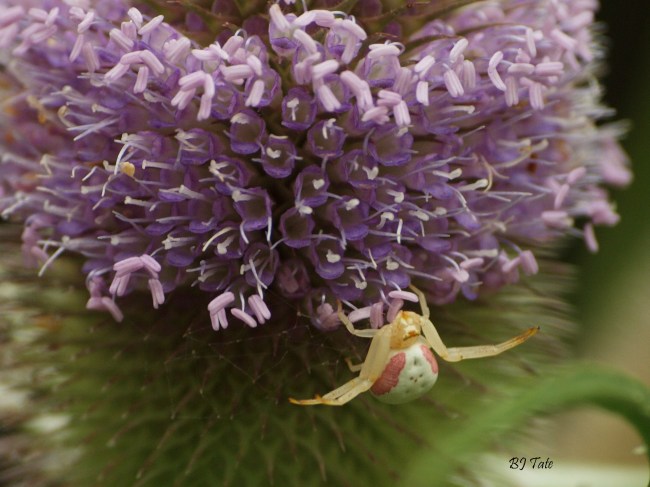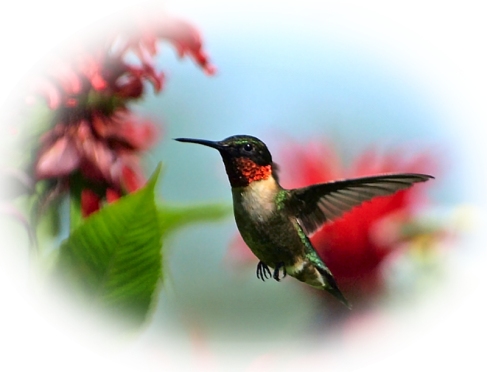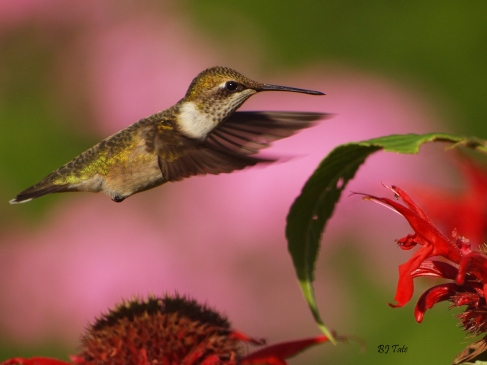But another sound followed them long after these had faded … – the tiny, dry sound of a spider weeping. – Peter S. Beagle, The Last Unicorn
As a photographer and friend of photographers, I view and share countless images. My internet tastes these days run to photos uploaded by people whose work I admire. I seek such photos elsewhere as well – in galleries and exhibits and art shops. Much of their subject matter is focused on the natural world, and a major aspect of that world is the macrocosm inhabited by small beings whose lives defy our full comprehension. While we can usually relate to – and even empathize with – a seal, groundhog, elephant or macaw, how do we establish a connection with, say, a crab spider? Where is the common ground between us and a centipede or earwig?
The local spiders, in particular, intrigue me because of their obvious work ethic, coupled with persistence in the face of adversity. I can’t help but applaud anyone or anything that is willing to build and rebuild, endlessly and without quitting, despite the cruel sweep of mortality that tears down every cable and strand and tower. Orb weavers craft remarkable webs, which human beings frequently rip apart – not always by accident. Wind and rain wreak further destruction on this fragile architecture. A dog crashing through tall grass can destroy the efforts of a hundred spider-hours within seconds. Yet the diminutive web-mistresses will begin their tasks again come nightfall, and each morning will see a fresh and glimmering array, suspended from branch or blade.
With the spiders that don’t make webs at all, but prefer to crouch on flowers or under leaves, there’s an immediacy that is lacking among the makers of thread. They simply grab their prey when it drops in for a bit of nectar or maybe to answer some mysterious call of nature; the intent is to snatch now and store for later, unless the spider is particularly hungry at the moment. It’s fascinating to watch this process. I’ve wasted … I mean spent … endless afternoons in quiet observation of the floral battlefields in my garden. Eventually, for the spider on her coneflower or centaurea, the deal-breakers are time and decay. Flowers wither and lose their appeal to pollen gathers. The arachnid population must pull up stakes and move to fresher territory. There’s not much action to be had on a shrivelled daisy. In the process of changing residence, undoubtedly some of these mobile tenants are lost to weather, birds, tires and feet. And in the end, they’ll die anyway, sooner rather than later. The life of a spider in our region is notoriously short, because we have cold winters here. The female argiope, for instance, hatches in the autumn of one year and exits during the first hard frost the following fall, not long after she has mated and left an egg case behind. It takes repeated attempts and clumsy errors before she can learn to craft the perfect web. All that effort, all those glorious gossamer dream-catchers hung from reeds and sedges … and then she’s gone.
So many people use the “poisonous spider” excuse as their reason for obliterating every creepy-crawler within range of a broom. The correct term is “venomous”, and while almost all spiders inject some sort of venom into their prey to immobilize it, that prey is usually small and puny – a fly, a beetle, a grasshopper, maybe a minnow. Most spiders don’t have the ability to penetrate human skin and inject much of anything. A few might bite in self-defence but the result is usually just a brief sting. We’re not talking rattlesnakes and pit vipers here. Even worldwide, comparatively few people are actually injured by spider bites and very few die – perhaps two a year, out of the billions on our planet. “Of around 50,000 spider species known, only about 25 (1/20 of 1%) have venom capable of causing illness in humans, to a greater or lesser extent. In any given locality you can expect to find from zero to (at most) three such species. These species are called ‘medically significant’ spiders.” http://www.burkemuseum.org/spidermyth/index.html We can be killed by many different antagonists among the wildlife we encounter; spiders aren’t even close to the top of the most-dangerous-animal list.
In Nova Scotia, we have no spiders with venom dangerous to humans. Ours are all harmless except to their prey. Most, in fact, help us by eating the insect pests we would prefer to do without. For me, if offered a choice between a big ol’ garden spider and a horde of blackflies that she is waiting to consume, I’ll always take the spider.
But this monologue isn’t about spider myths, or the sensationalist stories that often promote these myths and can be passed down through generations of the spider-scared. People averse to spiders, or actually afraid of them, won’t be convinced by any amount of factual reassurance. They will continue to hate spiders, react with strong exclamations when confronted with them, and comment on spider photos with decidedly negative responses. “Eeeuuwww” and “ugh” are fairly common examples. Still, this saddens me when I see it. Photographing spiders, for me, is both challenging and rewarding. If I can effectively capture the miniscule hairs on a yellow-and-black striped leg that’s under 2mm long, then my day has been a modest success.
So what’s the point? you ask. She likes to take spider pictures. Big whoop. For some people, that ranks right up there with being impaled on a steel fence surrounding their local sewage treatment pond. They’d rather haul out the smartphone and immortalize a lovely sunset over water, or maybe an apple tree clothed in pink and white. I almost feel sorry for them; I say “almost” because I take sunset and flowering-tree shots too.
The point is that we define beauty, and identify what is beautiful, in deeply personal ways. Keats once said that beauty and truth were the same thing. I’m not sure where that leaves the actress whose chest size keeps expanding to gratify some weird standard of “wow”, or the sixty-something with a Botox habit. Still, the man had a point. If we can’t celebrate the natural way something looks, acts and simply exists, it’s not likely we’ll be too excited about any amendments to that authenticity.
A spider is incapable of deception – except, again, towards its prey. It can sometimes mimic its surroundings by changing colour. It can hide and pretend to be an innocent blemish on a stem. But those ruses are still part of its essential makeup. All members of its clan will do the same; this is their “spiderness” kicking in. People, however, can misrepresent themselves for individual convenience, though not everyone will do it or try the same method of fakery. We have few basic traits for humanness that apply to each person. Most are culturally determined. To a spider, her culture embraces her entire species.
I do find these tiny beings quite lovely. They are symmetrical, and their eyes are astonishing – complex, often multiple, and clearly not capable of viewing their surroundings as I view mine. Many spider species are decorated with patterns as gorgeous as any found on clay pottery or intricate beadwork. Even the brownish spiders clinging to the side of my house are wondrous in their variety. No two will have identical markings. They seem similar but upon closer inspection, there will be definite amendments to the general design. I love these fat, tenacious creatures! Last winter, a leftover web attached across my kitchen window was so durable that it collected snowflakes during a storm and was transformed into a web of crystalline white. “Spider silk has incredible tensile strength and is often touted as being several times stronger than steel of the same thickness. What’s even more unique, however, is spider silk’s elasticity.” http://news.nationalgeographic.com/news/2005/01/0114_050114_tv_spider_2.html
I appreciate that the majority of highly visible spiders around my own home are female. The fair sex is bigger, more aggressive and prettier. The males are teensy-weensy, nondescript and expendable. In many spider species, they are useful for providing sperm for reproduction and then, immediately after that process (or even during the act itself), they supply nutrients for the female by allowing themselves to be eaten. They only ever get a first date, in other words – no follow-up. This sexual cannibalism is quite common and normally it’s the male who dies but in rare cases, certain species reverse the trend and the males dine on the females (talk about survival of the fittest!).
The other thing is that you never see a spider that looks ill or old, which isn’t true of most other species. Take butterflies, moths and bees, for instance – more widely-admired than spiders, although bee stings are responsible for thousands of anaphylactic shock episodes, and a fortune in epi-pens. These “cuter” bugs end up with worn and ragged wings, or patchy bald spots on their fuzzy bodies. Many mammals become arthritic, grey, thin and weak. Birds can lose feathers and develop a seedy appearance that does not bode well for their senior years. Fish float on the water with their eyes blank and bulging. But when spiders wear out, they just die and vanish (or dry up and blow away). They don’t hang around looking pitiful; they don’t cry either, even if they might want to. They’ve got most of us beat when it comes to finishing with panache.
Because I enjoy peering into the miniature landscape all around me, I do tend to boldly tiptoe where others tread only in work boots. When I happen to spot a nest of newly-emerged spiderlings, my first instinct is to run for the camera. It is never, ever to destroy the hundreds of babies heading into their brief spans under the sun. Their genes have dictated what they must do, and for how long. My genes have shaped me differently; fight-or-flight still operates, but there’s an added layer of rational thought and reflection that no spider can claim (yet). I could stomp and squash, but that wouldn’t help anyone. It would definitely not help the generation of new argiopes or shamrock orb weavers or jumping spiders looking to find homes around my yard.
Squashing the newborns, however, might immensely please the hordes of blackflies and mosquitoes that are tired of being stuck to spider threads and unceremoniously ingested. Then these winged terrors would be happily available to sample my skin. Now, I can’t find much about blood-sucking insects that I would call beautiful. The way they fit into the food chain, and nourish countless birds, is very significant. If there’s something to admire about them, this would be it. I watch the swallows careen all over the sky and understand that sometimes, if you can’t actually be lovely yourself, you can at least make loveliness happen elsewhere.
That’s what spiders do too. Every glittering September dawn reminds me that I would miss them terribly if they were suddenly extinguished. Shelob and her kind are fables. The reality is less exciting, perhaps, but far more reassuring to a gardener’s heart – far more tempting to a camera’s lens.
Arachnids of the world, arise and fulfill your destiny! You, too, are glorious and there is no need for you to weep.





